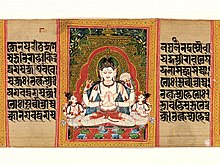Gouache

Gouache (/ɡuˈɑːʃ, ɡwɑːʃ/; French: [ɡwaʃ]), body color,[a] or opaque watercolor is a water-medium paint consisting of natural pigment, water, a binding agent (usually gum arabic or dextrin),[1] and sometimes additional inert material. Gouache is designed to be opaque. Gouache has a long history, having been used for at least twelve centuries. It is used most consistently by commercial artists for posters, illustrations, comics, and other design work.
Gouache is similar to
Description
Gouache paint is similar to
Gouache generally dries to a
Gouache is today much used by commercial artists for works such as posters, illustrations, comics, and for other design work. Most 20th-century animations used it to create an opaque color on a cel with watercolor paint used for the backgrounds. Using gouache as "poster paint" is desirable for its speed as the paint layer dries completely by the relatively quick evaporation of the water.
The use of gouache is not restricted to the basic opaque painting techniques using a brush and
History

A form of gouache, with honey or
During the eighteenth century gouache was often used in a mixed technique, for adding fine details in
Later that century, for decorative uses "poster paint" (as it is known in the U.S.), was mass-produced, based on the much cheaper dextrin binder. It was sold in cans or as a powder to be mixed with water. The dextrin replaced older paint types based on
-
Asphodelus ramosus by Hans Simon Holtzbecker, 1649–1659, gouache on parchment, 50.5 cm × 38.5 cm (20 in × 15+1⁄4 in)
-
Exeter and the Canal Basin by John Gendall between 1835 and 1840; watercolour and gouache on paper
-
Honoré Daumier, Une cause célèbre, ca.1862
-
Claude Monet, Sunset at Sea, 1865–70, Ashmolean Museum , Oxford
-
Glenn O. Coleman(1887–1932), 31 cm × 42 cm (12+1⁄4 in × 16+1⁄2 in)
-
Josep Maria Tamburini, Young Girl with a Hat, 1909, 38 cm × 25 cm (15 in × 9+3⁄4 in)
-
Léon Bénigni, cover design for Femina magazine, 1920s.jpg
-
Roman Nyman, stage design for a drama, 1923. Tartu Art Museum, Estonia
Acrylic gouache
A relatively new variation in the formula of the paint is acrylic gouache. Its highly concentrated pigment is similar to traditional gouache, but it is mixed with an acrylic-based binder, unlike traditional gouache, which is mixed with gum arabic. It is water-soluble when wet and dries to a matte, opaque, and water-resistant surface when dry. Acrylic gouache differs from acrylic paint because it contains additives to ensure the matte finish.[8]
See also
Notes
- ^ The alternate term "body color" is sometimes one word "bodycolor".
References
- ^ ISBN 9060178289.
- ISBN 0916724069.
- OCLC 1192031.
- ^ Vienna Parreno has painted on Braille paper. "Beyond Retinal Titillation: Seeing Red: Blog: Vienna Parreno". Archived from the original on 2008-08-01. Retrieved 2008-07-23.
- ISBN 019866107X
- ^ "The Minassian Collection of Persian, Mughal, and Indian Miniature Paintings". library.brown.edu. Retrieved 2020-08-10.
- ISBN 0-670-83701-6
- ISBN 9780823033140.
Sources
- "Bodycolor", thedrawingsite.com, 2009, web: TDS-bodycolor(archived 2012-02-27).
- Gouache at MSN Encarta-8754 archived 2009-10-28
External links
- Gouache from the Tate
- Demo of technique
- Info & history
- . Encyclopædia Britannica (11th ed.). 1911.








